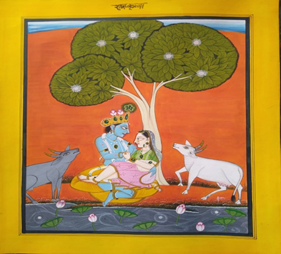

6th April 2023 (7 Topics)
Context
Recently, the Basholi (Basoli) paintings get the Geographical Indication (GI) tag following approval of the National Bank for Agriculture and Rural Development, Jammu.
About
- Basholi is a town in Kathua district in the state of Jammu and Kashmir, India.
- Basholi painting is a reputed school of miniature paintings.
- The Basohli painting of Kathua is the first independent GI-tagged product from Jammu region.
- Basohli painting, school of Pahari miniature painting that flourished in the Indian hill states during the late 17th and the 18th centuries, known for its bold vitality of colour and line.

- Key features:
- These paintings known for its vivid, evocative colors, bold lines, and deep-set facial patterns.
- It was founded by Raja Bhupat Pal in the 16th century.
- Basholi paintings are considered as the first school of Pahari paintings, many of which have evolved into the much more detailed and widespread style of Kangra painting school.
|
The Geographical Indication (GI) tag:
|
Paintings in India:
- Principles of Indian Paintings:
- Hinduism, Buddhism, and Jainism were three new religions that emerged in India, and they all provided important sources of inspiration for artists.
- The development of Indian Paintings has been significantly influenced by various factors, including India’s deep-rooted history and culture.
- In the famous paintings of India, spiritual themes, noble ideals, and common beliefs are depicted.
- In the third century AD, Vatsyayana wrote about the six main shadanga or principles of Indian painting in his work Kamasutra. These were:
- Various Forms: Rupabheda
- Emotional immersion: Lavanyayoganam
- Combining colours to simulate modelling effects: Varnikabhanga
- The proportion of the object or subject: Pramanam
- The portrayal of the subject’s likelihood: Sadrisyan
- The use of colour to create lustre and gleam: Bhava
Miniature Indian Paintings:
- When India first came into contact with the Islamic civilization, miniature painting finally reached its full potential.
- Indian painting underwent a new stage of development during the Mughal Empire when the workshops were created at the Imperial court.
- From there, artworks like illustrated manuscripts, book miniatures, portraiture, celebratory or genre scenes, and many others spread throughout India.
- Key features of miniature paintings:
- Miniature Indian paintings are characterized by small and detailed paintings.
- Human figures are mostly seen in side profiles, bulging eyes, slim waists pointed noses, etc.
- Different colours were used for different characters, and various bases were used.
- Often painted on paper, clothes, palm leaves, etc.
- The characteristics of Miniature painting varied in different regions of the country.
|
Some famous miniature paintings include;
|
More Articles


